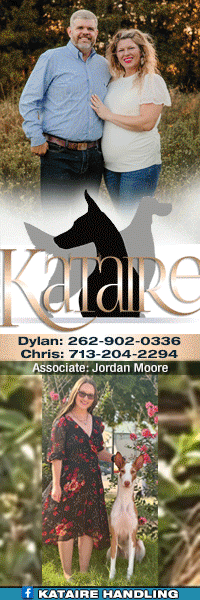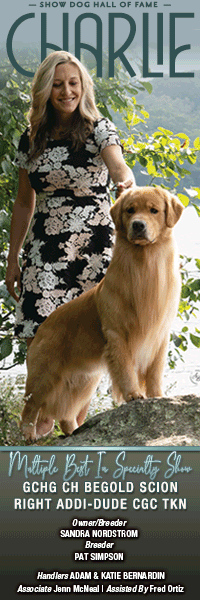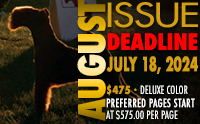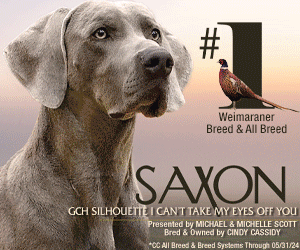Knowledge-Based Breeding
322 – August, 2010
by Dr. Carmen L. Battaglia
When two breeders meet in conversation they often exchange information about litters and then go about sharing ideas which eventually lead to a future breeding. These conversations remind me about how we learn from our exchanges of information, experience and mistakes all of which promote learning. Successful breeders know that they must be practical and patient in estimating the time and number of litters it will take to solve a problem or produce a special dog. Thus, when a planned breeding occurs there is usually the expectation for something good. It is an assumption based on the idea that if a really good pup comes along the breeder has sufficient skill and knowledge to recognize it. In this sense breeders are the producers of a product. Thus it makes no difference what product you produce, the goal is quality. Take, for example, the baker of cakes. We expect that a baker knows what a good cake looks like and can recognize a cake that has faults or shortcomings. A good baker is expected to be able to make a cake that is tall, flat or round. To do so requires knowing what ingredients are required, the bake time, and how the cake must be treated after it arrives.
Bakers and breeders both have the same objective, which is to produce something of perfection. If the producer of a puppy is only interested in the commercial aspect of breeding and intends to sell dogs only to make money or because they want some cute pups for their children, they will have no interest in this article. For those whose interest focuses on producing quality dogs that are close to the breed standard, sound in temperament with good health, read on.
KNOWLEDGE-BASED
In the past, before new technologies such as DNA tests and health databases were available, breeders did the best they could with what they had to work with. Today things are different. Knowledge-based breeding has emerged. This means that when quality information is collected and then coupled with the advancements of science, progress is more certain. Even with this kind of knowledge the time and effort required to fix a problem or produce litters of consistent quality is not always short and it cannot be quantified. For these reasons careful thinking is expected. For example, more is now known about how to analyze pedigrees and use new breeding methods. Take, for instance, the breeder who intends to produce a specific trait such as a dog with a body that is longer than tall, a wedge-shaped head, a strong and level back, or a tail that curls up or hangs down. In order to accomplish these things breeders must pay close attention to the traits of the ancestors and what they have produced. For breeders interested in improving the front assembly they must work to produce offspring that do not have forequarters with scapulars (shoulder blades) that are short and steep which give the appearance of a short neck. To avoid these pitfalls, information must be collected about the fourteen ancestors in the first three generations and, if possible, their littermates. In the simplest of terms, each breeding is a mix of genes from the sire and dam (50–50). The breeder who is serious about producing quality must study and evaluate these ancestors and then develop a strategy based on the information collected.
In order to shift the odds in favor of the breeder, knowledge-based breeding helps move the needle. It requires the collection of the right kinds of information and then the willingness to use it properly. It begins with the fourteen direct ancestors of the sire and dam (three generations). They are central to managing risk and making improvements.
Knowledge-based breeding translates into more than just knowing if a dog has produced a defect or is known to be a good producer. It is more than saving a few pups as replacements for older dogs. The example that follows explores how information which is gathered about the relatives in the first three generations can be used to make specific improvements. In practice, knowledge-based breeding begins with the reminder that there are two known ways to evaluate pedigrees. The first is called depth of pedigree which is the study of the 14 ancestors in the first three generations. Analysis of these relatives is important even though they only represent a small sample of a dog’s ancestors. The second is called breadth of pedigree. This approach includes the study of the littermates of the 14 direct ancestors. They significantly expand the number of relatives and the amount of information collected. As the number of relatives studied increases so do the chances for making improvements (Hovan, 2005). Of all the relatives that could be studied, those appearing in the first three generations are more likely to have the most impact on a litter.
To better illustrate this point hip dysplasia (HD) will be used as our example. This is a disease that results in an abnormality of the hip joint. The hip assembly is made up of a ball and socket joint in which the head of the femur (the “ball” at the top of the thigh bone fits into the socket of the pelvis – the acetabulum). In dysplastic dogs the joint fits loosely in a shallow acetabulum. HD occurs most commonly in rapidly growing large breeds, but it can also occur in small breeds. It affects the young (less than 1year old) and older (skeletally mature) dogs. Lameness is a common symptom which is attributed to joint laxity. Other clinical signs include a bunny-hopping gait. Symptoms include difficulty rising and exercise intolerance. HD affects both genders and is diagnosed via x-ray evidence.
To better illustrate the importance of expanding information, we will take two dogs. Call them “A” and “B”. In the first three generations both have 14 ancestors. If dog “A” has 9 of 14 ancestors that are known to have normal hips but little or nothing is known about the hips of the littermates of these ancestors, “A” would be considered a good candidate for producing sound hips until another dog is found with a better pedigree. If Dog “B” has 10 of 14 ancestors with normal hips and several other ancestors that have littermates with normal hips, “B” would be considered a better candidate than “A” for producing normal hips. Dogs that are known to have ancestors and littermates (depth and breadth) with a desired trait are considered the better breeding candidates. This example demonstrates the principle of knowledge-based breeding using depth and breadth of a pedigree to make improvements and manage risk.
BREEDING TOOLS
BREEDER TOOLS
- My AKC – Free, offered by AKC (tracks dogs and offspring )
- Pedigree software, speeds up coding and tracking traits
- Continuing education – See breeder site: www.breedingbetterdogs.com
- DNA Tests – Diagnostic tests, posted at: www.breedingbetterdogs.com
- Orthopedic Foundation for Animals (OFA) – This paper
- Canine Health Information Center (CHIC) – This paper
- Mating Probability Table – This paper (Keller, 2006)
- Desirability Check List – This paper (Keller, 2006)
- Three pedigrees – Traditional, Stick Dog Color Chart, Symbol (Battaglia 2009)
- AKC registrations and microchips – Positive ID, tracking and recovery
- Knowledge-based breeding also includes using tools some of which are listed in Figure 1.
One tool that has a practical use for improving hips is called the Mating Probability Table. It was developed by the OFA and is based on 444,451 progeny with known sire and dam scores (See Table 1).
This table provides a practical approach to risk management. For example, if a breeder had a sire with an “excellent” hip rating (upper left corner of Table 1) and if this dog were bred to a female that has a “fair” rating for hips, Table 1 shows that 90% of their offspring would be expected to be normal and 10% would be expected to be dysplastic. These data represent breeding expectations and not guarantees. Hip evaluations are based on phenotypic information based on radiographs not DNA. Therefore, these evaluations are an analysis of the phenotype and are not genetic predictions of what a dog might produce. This means there is always a risk when breeding regardless how good the radiographic evaluations. Table 1 serves to illustrate the level of risk one will take just by knowing the status of the sire and dam’s hips. In addition to the Mating Probability Table, the OFA suggests that practical guidelines be used when making decisions about sires and dams. The guidelines are called the Desirability Check List (Keller, 2006). It requires the collection of information to answer four questions.
FIGURE 1. DESIRABILITY CHECK LIST
- Frequency of the desired trait occurring among the 14 direct ancestors (3 generations) – Depth of Pedigree
- Frequency of desired trait occurring among the littermates of the direct ancestors (3 generations) – Breadth of Pedigree
- Number of carriers or affected littermates and ancestors (3 generations)
- Number of offspring produced with the desirable and undesirable traits.
These two breeder tools, when used, expand the quality of information and shift the odds in favor of the breeder.
A third tool that has broad use is the Canine Health Information Center or CHIC (found at www.caninehealthinfo.org). It was established by the American Kennel Club, Canine Health Foundation (CHF) and the Orthopedic Foundation for Animals. CHIC is an online registry that works with parent clubs to establish a panel of testable genetic disorders that each club believes should be screened for in their breed. The strategy underlying CHIC is that dogs achieve CHIC certification by completing the health-checks. Passing each health test is not a requirement for certification. The CHIC program emphasizes health consciousness, not about being faultless. Each Parent Club decides whether to enroll in the CHIC program and determine the testable genetic disorders for their breed. For example, one club might select hip evaluation, CERF examination, and cardiac testing. Another might choose hips, elbows and thyroid testing. Owners, breeders, and prospective owners can search online for dogs in the OFA/CHIC database, and view their test results. If a dog completes the recommended testing panel, it receives a CHIC number regardless of whether it passes all of the tests. CHIC is about health consciousness, not health perfection. As more testable disorders are identified, few dogs will be normal for all tests. Another breed tool is the Orthopedic Foundation for Animals (OFA: www.offa.org). It has semi-open registries for hip dysplasia, elbow dysplasia, autoimmune thyroiditis, congenital cardiac disease, and patella luxation. From the OFA web portal you can look up individual dogs and their health testing status.
Both OFA and CHIC are health registries that allow for open disclosure of all health-test results or semi-open disclosure listing only normal results. In the United States, several genetic registries have been established to assist breeders with genetic disease control. The Canine Eye Registry Foundation or CERF (http://www.vmdb.org/cerf.html) is a closed database showing only normal eye examination results by ACVO boarded veterinarians.
SUMMARY
Knowledge-based breeding has changed the landscape for breeding better dogs. Those who use this approach have begun to think in terms of breeding by direction rather than by chance. By using technology and information the number of errors can be reduced. Given the advances that are now available via knowledge-based breeding more can be expected of today’s breeders than those in the past. Thus knowledge coupled with quality breeding stock moves the needle forward.
References:
Battaglia, C., 2010. Breeding Dogs to Win, BEI Publications, Atlanta, Ga., pp. 95-
Bell J., 2010. Facing breed related diseases as a vet – practical and ethical aspects, presented at the world small animal veterinary association conference,
Geneva, Switzerland, June 3.
Hovan, R. 2005. Collecting and utilizing phenotypic data to minimize disease: A breeder’s practical guide. Tufts’ canine and feline breeding and genetics conference, Sturbridge, MA Sept., 30- Oct., 1.
Keller, G., 2006, The use of health databases and selective breeding, OFA, Columbia, Mo. pp. 7-11.
Short URL: http://caninechronicle.com/?p=1426
Comments are closed












